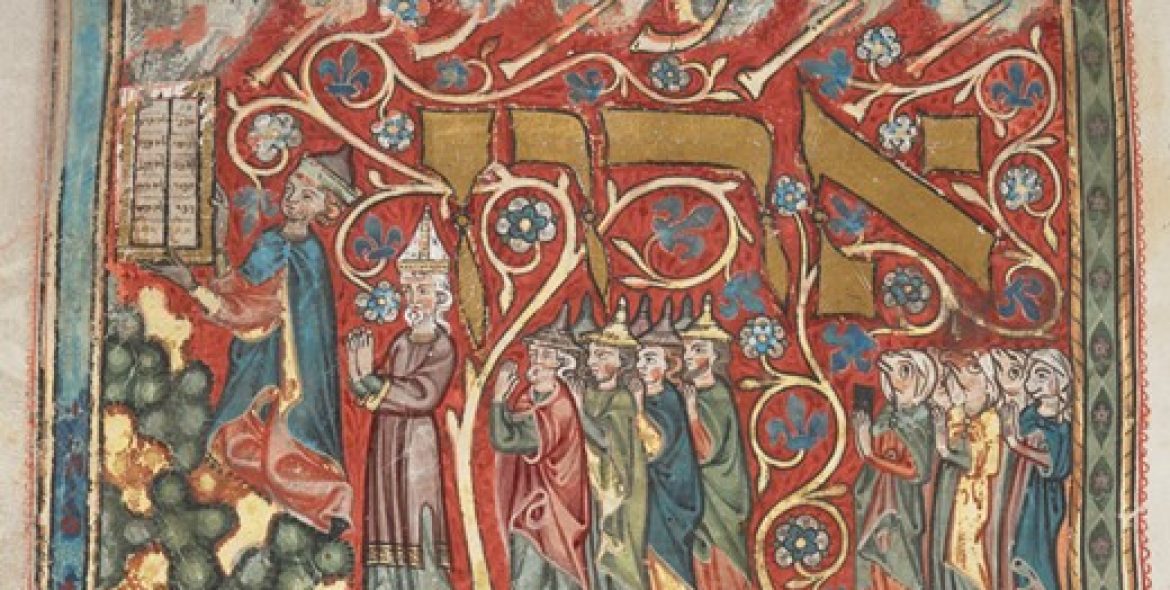The Tripartite Mahzor is an illuminated Hebrew manuscript from Ashkenaz, dating to the 14th century, regarded as a unique gem of Jewish medieval art. Its name derives from its division into three parts, each now kept in a different library around the world. The Mahzor mainly depicts musical scenes related to biblical stories, as seen in the illustration before us of song in the bible. However, this post will also touch indirectly on another kind of music — vocal music, namely singing in the Bible.
In this post, I would like to offer a fresh look at the well-known illustration “The Crossing of the Red Sea and the Song of Miriam” from the Mahzor and propose a new possible interpretation of its meaning.
You can view the illustration here:
Illustration of the Crossing of the Red Sea and the Song of Miriam, Tripartite Mahzor – Folio 197r.
The biblical inspiration for the illustration is clear: “Then Miriam the prophetess, Aaron’s sister, took a tambourine in her hand, and all the women went out after her with tambourines and with dances.”
(Exodus 15:20–21)
Gender Separation – A Visual Reading
Shalev-Eyni points out that in the illustration, the group of men is separated and stands before the group of women (the women’s faces in the illustration are depicted with zoomorphic features — animal heads). Similarly, in the “Giving of the Torah” illustration in the Tripartite Mahzor, a similar separation is evident: the women are positioned behind the men.
In the “Crossing of the Red Sea” illustration, Miriam and the women appear to be playing instruments and dancing, but the men are not facing them — their heads are turned in the opposite direction, suggesting that they probably do not even hear or view them. This subtle separation aligns with the Talmudic prohibition of “kol b’isha ervah” (“a woman’s voice is considered nakedness”; Babylonian Talmud, Kiddushin 70a). I have discussed this matter in an earlier post on this site.
Midrashic Interpretations and Additional Commentary
According to Shalev-Eyni, it is possible that the gender separation is based on a Midrash quoted in commentary on the liturgical poems in the Mahzor: just as Moses sang for the men, so Miriam sang for the women.
This idea also appears in Midrash Tehillim (Shocher Tov, Buber edition, Psalm 68):
“First the singers, then the players,” meaning the men lead the singing.
In Pesikta Zutarta (Lekach Tov, Exodus 15), it is explained that since Moses and Aaron brought about the salvation, they precede the women, unlike the Song of Deborah, where women’s singing comes before men’s because there a woman vrought about the victory and salvation.
However, not all Midrashim agree: in Pitron Torah (on Parashat Ha’azinu), it is said that the women began the singing or playing, followed by the Israelites and then by the ministering angels.
Artistic Resonance from the Christian World
The separation between men and women in the Song at the Sea also appears in the Byzantine Christian tradition.
For example, in the title of Origen’s sixth homily (3rd century):
“On the song sung by Moses with the people and by Miriam with the women.”
This view influenced additional Christian medieval commentators, such as Rupert of Deutz in his De Sancta Trinitate.
A New Interpretative Proposal
In this post, I propose another possible reason for the presence of women behind the men in the illustration — a reason not necessarily connected to it being another example of song in the Bible:
It might reflect a broader representational pattern in medieval Ashkenazic Hebrew manuscript illustrations, where women are depicted behind men in other biblical scenes as well — even when no singing is described.
For example, in the “Giving of the Torah” illustration in the Tripartite Mahzor (the main image of this post), a clear separation with men in front of the women is also depicted.
Thus, the illustration may not have been intended primarily to convey a restrictive message about instrumental music or song in the Bible by women, but rather to reflect another visual convention found in other medieval Hebrew manuscripts.
A Thought for the Future
It seems that the “women following men” motif in several medieval Hebrew manuscript illustrations might merit further research, which could shed more light on this issue.
This is an intriguing question for future study — and maybe even a topic for another blog post? (-: …
For further reading:
- Zofia Buda, Animals and Views on Women: Zoomorphic Figures in the Tripartite Mahzor, 2005
- Sarit Shalev-Eyni, Jews Among Christians: Illustrated Hebrew Manuscripts of the Middle Ages, 2010
- Guy Shaked, The Jewish attitude towards the playing of music in the Tripartite Mahzor, 2020
Copyright © 2025 Guy Shaked. All rights reserved.
Posted: 26-April-2025, 20:30 (Jerusalem Time)
Modified:


